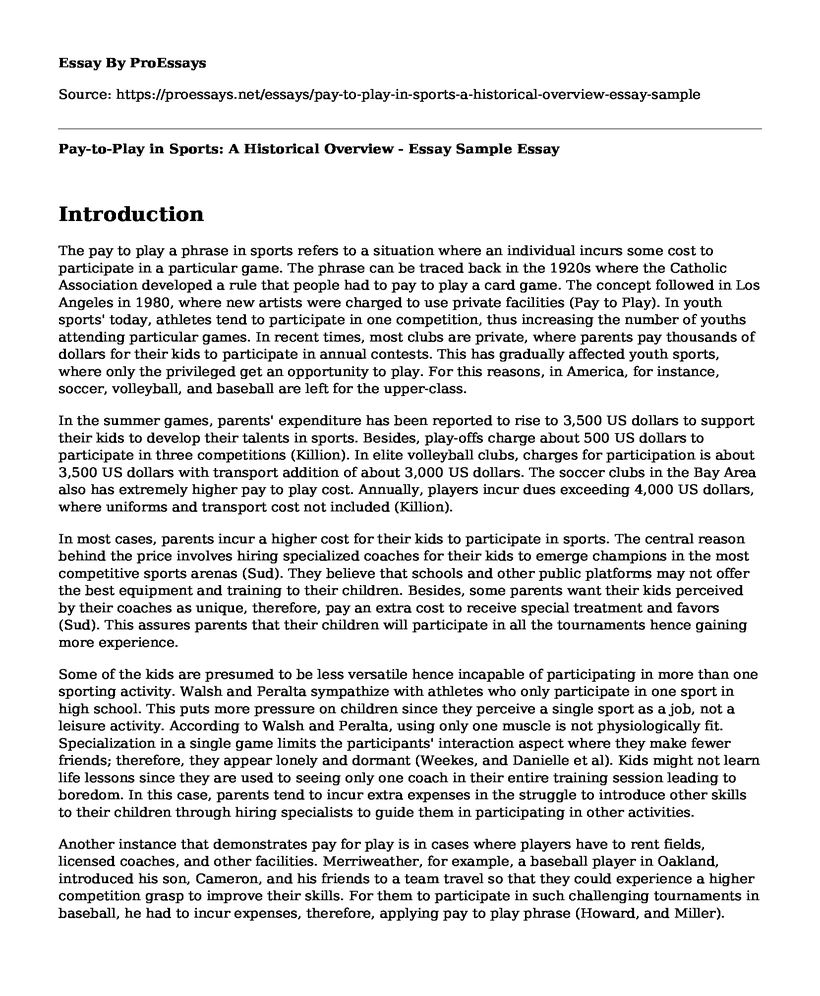Introduction
The pay to play a phrase in sports refers to a situation where an individual incurs some cost to participate in a particular game. The phrase can be traced back in the 1920s where the Catholic Association developed a rule that people had to pay to play a card game. The concept followed in Los Angeles in 1980, where new artists were charged to use private facilities (Pay to Play). In youth sports' today, athletes tend to participate in one competition, thus increasing the number of youths attending particular games. In recent times, most clubs are private, where parents pay thousands of dollars for their kids to participate in annual contests. This has gradually affected youth sports, where only the privileged get an opportunity to play. For this reasons, in America, for instance, soccer, volleyball, and baseball are left for the upper-class.
In the summer games, parents' expenditure has been reported to rise to 3,500 US dollars to support their kids to develop their talents in sports. Besides, play-offs charge about 500 US dollars to participate in three competitions (Killion). In elite volleyball clubs, charges for participation is about 3,500 US dollars with transport addition of about 3,000 US dollars. The soccer clubs in the Bay Area also has extremely higher pay to play cost. Annually, players incur dues exceeding 4,000 US dollars, where uniforms and transport cost not included (Killion).
In most cases, parents incur a higher cost for their kids to participate in sports. The central reason behind the price involves hiring specialized coaches for their kids to emerge champions in the most competitive sports arenas (Sud). They believe that schools and other public platforms may not offer the best equipment and training to their children. Besides, some parents want their kids perceived by their coaches as unique, therefore, pay an extra cost to receive special treatment and favors (Sud). This assures parents that their children will participate in all the tournaments hence gaining more experience.
Some of the kids are presumed to be less versatile hence incapable of participating in more than one sporting activity. Walsh and Peralta sympathize with athletes who only participate in one sport in high school. This puts more pressure on children since they perceive a single sport as a job, not a leisure activity. According to Walsh and Peralta, using only one muscle is not physiologically fit. Specialization in a single game limits the participants' interaction aspect where they make fewer friends; therefore, they appear lonely and dormant (Weekes, and Danielle et al). Kids might not learn life lessons since they are used to seeing only one coach in their entire training session leading to boredom. In this case, parents tend to incur extra expenses in the struggle to introduce other skills to their children through hiring specialists to guide them in participating in other activities.
Another instance that demonstrates pay for play is in cases where players have to rent fields, licensed coaches, and other facilities. Merriweather, for example, a baseball player in Oakland, introduced his son, Cameron, and his friends to a team travel so that they could experience a higher competition grasp to improve their skills. For them to participate in such challenging tournaments in baseball, he had to incur expenses, therefore, applying pay to play phrase (Howard, and Miller).
Conclusion
In summary, the pay to play perception in sports have declined participation in various games. Sports and other essential activities are left to a few individuals with a higher social status in society. It has drastically affected the process of nurturing skills and talents among the young generation. Most of the youths miss the opportunity to participate in tournaments due to a lack of resources to fund them. In my perspective, sports participation among the youths should be based on competence and skills but not on social status hence promoting equality.
Works Cited
"Definition Of Pay-To-Play | Dictionary.Com". Www.Dictionary.Com, 2019, https://www.dictionary.com/browse/pay-to-play.
Howard, Larry W., and Janis L. Miller. "Fair Pay For Fair Play: Estimating Pay Equity In Professional Baseball With Data Envelopment Analysis". Academy Of Management Journal, vol 36, no. 4, 1993, pp. 882-894. Academy Of Management, doi:10.5465/256763.
Killion, Ann. "Paying To Play Is New Normal For Youth Athletes". Sfgate, 2013, https://www.sfgate.com/sports/article/Paying-to-play-is-new-normal-for-youth-athletes-4902034.php. Accessed 22 Nov 2019.
Sud, Seema. Http://Www.Versatilekids.Com, 2015, https://ke.linkedin.com/company/versatile-kids-inc. Accessed 22 Nov 2019.
Weekes, Danielle G., et al. "The Effect of Single Sport Specialization in Youth Sports: Does It Increase the Risk of Injury? A Prospective Study." Orthopaedic Journal of Sports Medicine 7.7_suppl5 (2019): 2325967119S00408.
Cite this page
Pay-to-Play in Sports: A Historical Overview - Essay Sample. (2023, Mar 03). Retrieved from https://proessays.net/essays/pay-to-play-in-sports-a-historical-overview-essay-sample
If you are the original author of this essay and no longer wish to have it published on the ProEssays website, please click below to request its removal:
- Essay Sample: Rowing as a Business Around the World
- Research Paper Example: Benefits of Exercising Once a Day
- Why Steroids Hinder an Athlete's Performance Essay
- Controversial Athlete: Tommie Smith Essay
- Essay Example on Exercise Science: The Pros and Cons of Popularity
- Essay Sample on Student-Athletes: The Powerhouses of the Sports Industry
- Achieving Physical Literacy: The Fifth Standard of Physical Education - Essay Example







